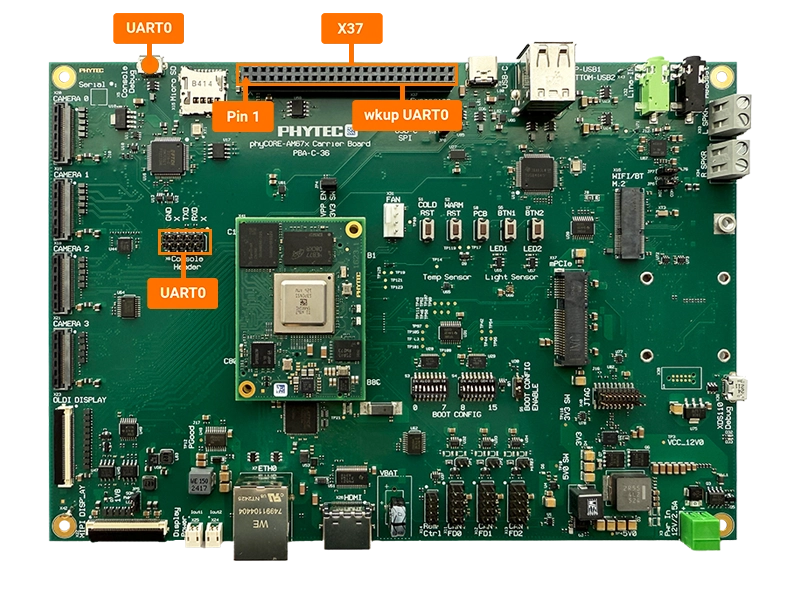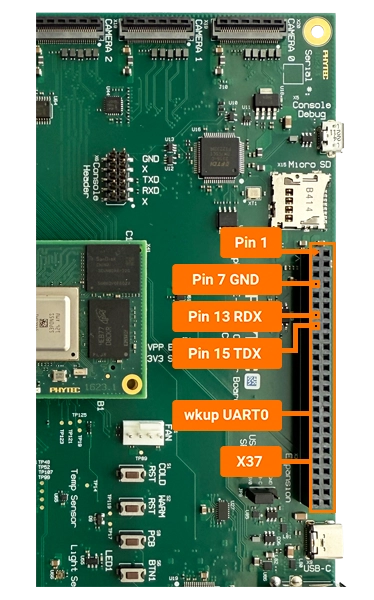UART
The phyCORE-AM67x provides access to up to 9 UART interfaces that can be used for configuration and data exchange with external peripheral devices. The phyBOARD-Rigel AM67x provides access to five of these interfaces through expansion connectors.
By default, the phyBOARD-Rigel AM67x is configured to use UART0 for a Linux console input and output. The UART0 signal is available through a micro-USB connector X5 via a UART to USB bridge. PHYTEC recommends allocating UART0 for console access on custom designs. You can see all available UART interfaces in the images and tables below. To learn more information about the phyCORE-AM67x UART interface, please see sections 7.5 and 11.3 in the Hardware Manual.

The UART channels correspond to the following connectors and system paths.
UART |
Connector |
Character Device File |
Status |
|---|---|---|---|
UART0 |
X49 (Micro USB), X6 (10-pin Header) |
/dev/ttyS2 |
Default Linux Console at X49 X6 is currently unavailable |
WKUP_UART0 |
X37 (Exp Connector) |
/dev/ttyS3 |
Requirements
3x M/M Jumper Wire
Note
The expansion header was designed for 2mm pins. It is acceptable to use 2.54mm jumper pins during the development and verification of interfaces. The only issue arises when you switch back to plugging in a 2mm male header for an expansion board you created.
Hardware Setup
Power off and remove the power supply from the phyBOARD-Rigel AM67x.
sh-phyboard-rigel-am67xx-1:~# poweroff
Connect the TTL Cable to the expansion header X37. Do not connect the cable to your host system yet.
GND |
Black Connecter |
Pin 7 (X37) |
|---|---|---|
TXD |
Orange Connecter |
Pin 15 (X37) |
RXD |
Yellow Connecter |
Pin 13 (X37) |

Power the phyBOARD-Rigel AM67x back on.
Inspect dmesg output to figure out the TTL device of the UART to USB bridge cable. If you already have connected a cable to the USB debug port, your TTL device will be very likely /dev/ttyUSB3.
Setting the Baud Rate
Before using the UART interface, you need to configure the baud rate. The following command sets the baud rate to 115200 bps for the UART interface:
sh-phyboard-rigel-am67xx-1:~# stty -F /dev/ttyS3 115200
You can verify the current settings using:
sh-phyboard-rigel-am67xx-1:~# stty -F /dev/ttyS3 -a
Sending Messages
To send data through the UART interface, you can use the echo command to write to the device:
sh-phyboard-rigel-am67xx-1:~# echo "Hello World" > /dev/ttyS3
For continuous transmission, you can use a loop:
sh-phyboard-rigel-am67xx-1:~# while true; do echo "Test Message" > /dev/ttyS3; sleep 1; done
Receiving Messages
To read incoming data from the UART interface, use the cat command:
sh-host:~$ cat /dev/ttyS3
This will display any incoming messages in real-time. Press Ctrl+C to stop reading.
For debugging purposes, you can also use minicom. Install it using:
sh-host:~$ sudo apt update sh-host:~$ sudo apt install minicom
Start minicom:
sh-host:~$ minicom -D /dev/ttyS3 -b 115200
Booting via UART
See chapter UART on how to boot from UART.